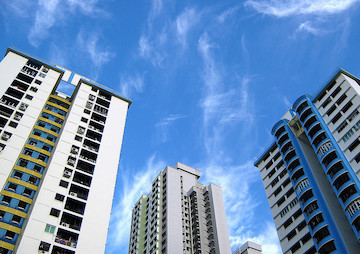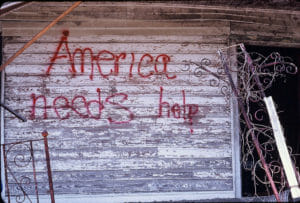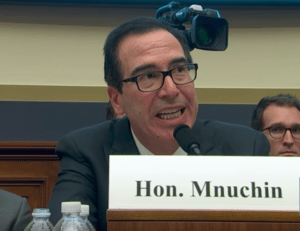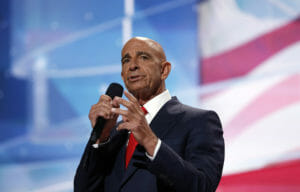So You Want to Ditch Your Landlord
“Real estate as a store of private wealth is the rotten tree that sprouts [the] diseased branches” of homelessness, unaffordable urban real estate, gentrification and dangerous housing bubbles, writes Jesse A. Meyerson at The Nation. “[T]he solution is to quit pruning twigs and chop the sucker down.” yeowatzup / CC BY 2.0
yeowatzup / CC BY 2.0
“Real estate as a store of private wealth is the rotten tree that sprouts [the] diseased branches” of homelessness, unaffordable urban real estate, gentrification and dangerous housing bubbles, writes Jesse A. Meyerson at The Nation. “[T]he solution is to quit pruning twigs and chop the sucker down.”
Why, Mr. Meyerson? He answers first by reviewing what private housing is.
First off, it is mostly land. That is, real estate is the most valuable asset form in the United States, and the majority of that value is not that of the building itself, which depreciates until it requires renovation, but of the “unimproved” land it sits on—the location. Imagine a skyscraper filled with sumptuous luxury condominiums, located in the center of Antarctica: However many millions had gone into its cutting-edge furnishings, without a community (parks, transit options, schools, shops, etc.) around to situate it in a desirable location, that building would be worthless as a real-estate investment. These community resources are reflected in what is commonly called “land value,” but is more precisely the price of the location. Rather than flowing to the community that created it, however, it is captured by individual real-estate owners.
More fundamentally, though, what we call private housing is actually public land that government has set aside for private purposes. Land, save the bits beneath one’s feet, can’t be “possessed,” as a phone or a shirt can. What a “land owner” possesses is a deed—a voucher one may redeem with the government to marshal violence (through policing) to exclude all competing claimants. The government established this location-exclusion program, designating pieces of nature as being solely for the use of the deed holders, and devoting its violent capabilities to enforcing that designation. In the 19th century, the government enacted homesteading laws to allow frontier settlers to claim indigenous lands as their own. If those deeds were challenged, the federal government sent troops to back them up. Or look at the 20th century, when the government funded highways and commuter transit—the Federal Housing Administration extended loan guarantees to new housing developments in order to create a massive suburban private-housing stock. The entire apparatus by which housing is privately “owned” is created by the government’s decisions to subsidize or protect certain interests.
Ostensibly, the government pursues the public interest, but treating real estate as privately owned wealth, as a financial asset, has devastating public effects. On a grand scale, treating land as an asset allows speculators to create bubbles large enough to threaten global economic collapse. […]
Closer to home, private ownership of land underlies racist segregation. The aforementioned FHA policy, for instance, designed to protect homeowners’ access to gains in their houses’ location value, provided white people with the incentive to take their capital and flee urban centers for sprawling exurban developments, there to adopt racial exclusivity covenants, in order to prevent black people from moving in […]
Finally, developers have an incentive to snap up urban land and then leave it vacant until it appreciates in value, driven by community development around it, and then sell it. Meanwhile, residents have to live with the social repercussions of a community riddled with vacant lots.
What then can be done? Meyerson considers exclusion fees (taxes paid to the public for exclusive use of property), community land trusts (organizations that give community representatives voting power over development and its terms), and ultimately, public housing (the ownership and management of housing by bureaus overseen by elected representatives answerable to voters).
Many Americans are reflexively opposed to the third option — granting government administrations authority over housing — because corruption at the federal, state and local levels has robbed them of faith in government and democracy itself. This is unfortunate because not all officials are bought by private interests. A government staffed by genuinely public-minded people remains possible — and eminently so in smaller communities where officials fear opposition by neighbors whose votes they must obtain to win office.
In communities throughout the U.S. and elsewhere in the world we can catch glimpses of what is possible. Meyerson tells us:
The Dudley Street Neighborhood Initiative transformed more than 32 acres of land in Boston from commodity to community. Regarding how it was able to perform this transformation, and how it has successfully resisted an economic system that greedily militates for land to be privatized, Eliza Parad, a DSNI community organizer, cites “the political power this community, a majority community of color, has built since the 1970s.” As the lives of the Dudley Street neighbors testify, land removed from the private market, de-commodified, and placed under the ownership and management of the people who live there is land that creates and renews its own political constituency.
Likewise, the Vienna model of public and publicly managed housing is politically insulated, because it encompasses nearly half the city. In US cities, the residents of public-housing projects constitute a small minority of easily marginalized and maligned poor people, ill-equipped to do battle with landed interests. Thus, Baltimore offers millions in tax breaks to developers to buy up the public housing stock, while the working-class Viennese residents of Karl Marx Court enjoy their saunas.
— Posted by Alexander Reed Kelly.
Your support matters…Independent journalism is under threat and overshadowed by heavily funded mainstream media.
You can help level the playing field. Become a member.
Your tax-deductible contribution keeps us digging beneath the headlines to give you thought-provoking, investigative reporting and analysis that unearths what's really happening- without compromise.
Give today to support our courageous, independent journalists.






You need to be a supporter to comment.
There are currently no responses to this article.
Be the first to respond.